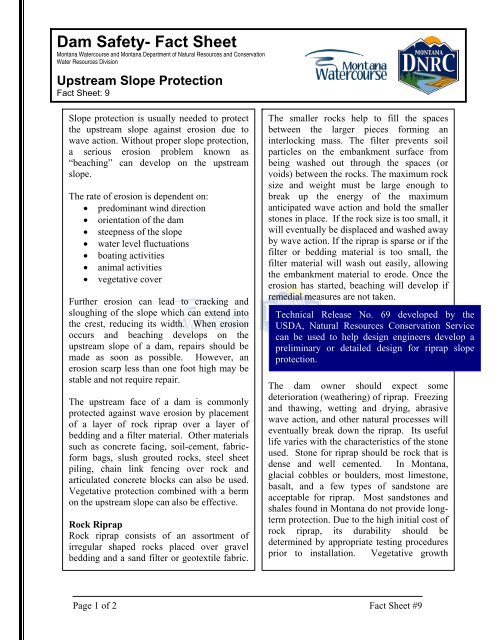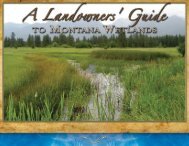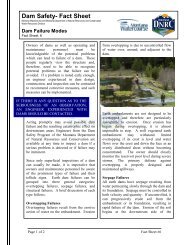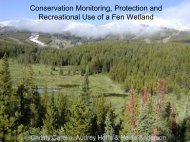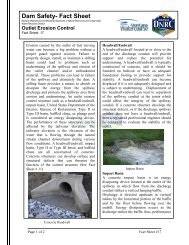Upstream Slope Protection - Montana Watercourse
Upstream Slope Protection - Montana Watercourse
Upstream Slope Protection - Montana Watercourse
Create successful ePaper yourself
Turn your PDF publications into a flip-book with our unique Google optimized e-Paper software.
Dam Safety- Fact Sheet<br />
<strong>Montana</strong> <strong>Watercourse</strong> and <strong>Montana</strong> Department of Natural Resources and Conservation<br />
Water Resources Division<br />
<strong>Upstream</strong> <strong>Slope</strong> <strong>Protection</strong><br />
Fact Sheet: 9<br />
<strong>Slope</strong> protection is usually needed to protect<br />
the upstream slope against erosion due to<br />
wave action. Without proper slope protection,<br />
a serious erosion problem known as<br />
“beaching” can develop on the upstream<br />
slope.<br />
The rate of erosion is dependent on:<br />
• predominant wind direction<br />
• orientation of the dam<br />
• steepness of the slope<br />
• water level fluctuations<br />
• boating activities<br />
• animal activities<br />
• vegetative cover<br />
Further erosion can lead to cracking and<br />
sloughing of the slope which can extend into<br />
the crest, reducing its width. When erosion<br />
occurs and beaching develops on the<br />
upstream slope of a dam, repairs should be<br />
made as soon as possible. However, an<br />
erosion scarp less than one foot high may be<br />
stable and not require repair.<br />
The upstream face of a dam is commonly<br />
protected against wave erosion by placement<br />
of a layer of rock riprap over a layer of<br />
bedding and a filter material. Other materials<br />
such as concrete facing, soil-cement, fabricform<br />
bags, slush grouted rocks, steel sheet<br />
piling, chain link fencing over rock and<br />
articulated concrete blocks can also be used.<br />
Vegetative protection combined with a berm<br />
on the upstream slope can also be effective.<br />
Rock Riprap<br />
Rock riprap consists of an assortment of<br />
irregular shaped rocks placed over gravel<br />
bedding and a sand filter or geotextile fabric.<br />
The smaller rocks help to fill the spaces<br />
between the larger pieces forming an<br />
interlocking mass. The filter prevents soil<br />
particles on the embankment surface from<br />
being washed out through the spaces (or<br />
voids) between the rocks. The maximum rock<br />
size and weight must be large enough to<br />
break up the energy of the maximum<br />
anticipated wave action and hold the smaller<br />
stones in place. If the rock size is too small, it<br />
will eventually be displaced and washed away<br />
by wave action. If the riprap is sparse or if the<br />
filter or bedding material is too small, the<br />
filter material will wash out easily, allowing<br />
the embankment material to erode. Once the<br />
erosion has started, beaching will develop if<br />
remedial measures are not taken.<br />
Technical Release No. 69 developed by the<br />
USDA, Natural Resources Conservation Service<br />
can be used to help design engineers develop a<br />
preliminary or detailed design for riprap slope<br />
protection.<br />
The dam owner should expect some<br />
deterioration (weathering) of riprap. Freezing<br />
and thawing, wetting and drying, abrasive<br />
wave action, and other natural processes will<br />
eventually break down the riprap. Its useful<br />
life varies with the characteristics of the stone<br />
used. Stone for riprap should be rock that is<br />
dense and well cemented. In <strong>Montana</strong>,<br />
glacial cobbles or boulders, most limestone,<br />
basalt, and a few types of sandstone are<br />
acceptable for riprap. Most sandstones and<br />
shales found in <strong>Montana</strong> do not provide longterm<br />
protection. Due to the high initial cost of<br />
rock riprap, its durability should be<br />
determined by appropriate testing procedures<br />
prior to installation. Vegetative growth<br />
Page 1 of 2 Fact Sheet #9
within the slope protection is undesirable<br />
because it can displace stone and disturb the<br />
filter material. Heavy undergrowth prevents<br />
an adequate inspection of the upstream slope<br />
and may hide potential problems. For<br />
additional information, see the “Trees and<br />
Brush” fact sheet.<br />
Vegetated Wave Berm<br />
Vegetated wave berms dissipate wave energy<br />
and protect the slope from erosion. Berms are<br />
constructed on the upstream slope at the<br />
normal pool level and should be no less than<br />
20 feet wide. This method of slope protection<br />
will not work well where the water surface<br />
fluctuates regularly from normal pool. If<br />
improper or sparse vegetation is present, the<br />
wave berm may not adequately dissipate the<br />
wave energy, allowing erosion and beaching<br />
to develop on the upstream slope.<br />
Technical Release No. 56 developed by the<br />
USDA, Natural Resources Conservation Service<br />
provides design and layout information for<br />
vegetated wave berms.<br />
The vegetation on the wave berm should be<br />
monitored regularly to verify adequate<br />
growth. Sufficient funds should be allocated<br />
for the regular maintenance of the vegetation.<br />
Severe erosion or reoccurring problems may<br />
require a registered professional engineer to<br />
design a more effective slope protection.<br />
Concrete Facing<br />
Concrete facing can be used if severe wave<br />
action is anticipated, however, settlement of<br />
the embankment must be insignificant to<br />
insure adequate support for the concrete<br />
facing. A properly designed and constructed<br />
concrete facing can be expensive. This slope<br />
protection should extend several feet above<br />
and below the normal pool level. It should<br />
terminate on a berm or against a concrete<br />
curb or header. Granular filter or filter fabric<br />
(geotextile) is required under the concrete<br />
facing to help reduce the risk of undermining.<br />
As with any type of slope protection,<br />
problems will develop if the concrete facing<br />
has not been properly designed or installed.<br />
Concrete facing often fails because the wave<br />
action washes soil particles from beneath the<br />
slabs through joints and cracks. This process<br />
is known as undermining, which will continue<br />
until large voids are created. Detection of<br />
voids is difficult because the voids are<br />
hidden. Failure of the concrete facing may be<br />
sudden and extensive. Concrete facing<br />
should be monitored for cracks and open<br />
joints. Open joints should be sealed with<br />
plastic fillers, and cracks should be grouted<br />
and sealed (See Dam Fact Sheet #12).<br />
Inspection and Monitoring<br />
Regular inspection and monitoring of the<br />
upstream slope protection is essential to<br />
detect any problems. It is important to keep<br />
written records of the location and extent of<br />
any erosion, undermining, or deterioration of<br />
the riprap, wave berm or other slope<br />
protection. Photographs provide invaluable<br />
records of changing conditions. A rapidly<br />
changing condition may indicate a very<br />
serious problem, and the Dam Safety Program<br />
should be contacted immediately.<br />
For more questions, comments, additional fact<br />
sheets, and area specific information you can<br />
contact DNRC or <strong>Montana</strong> <strong>Watercourse</strong> at the<br />
addresses below or on the web.<br />
<strong>Montana</strong> <strong>Watercourse</strong><br />
PO Box 170570<br />
Bozeman, MT 59717-0570<br />
406-994-6671<br />
www.mtwatercourse.org<br />
<strong>Montana</strong> Department of<br />
Natural Resources and Conservation<br />
Water Resource Division<br />
Dam Safety Program<br />
1424 9th Avenue<br />
PO Box 201601<br />
Helena, MT 59620-1601<br />
406-444-6613<br />
www.dnrc.mt.gov/wrd/water_op/dam_safety<br />
Page 2 of 2 Fact Sheet #9


